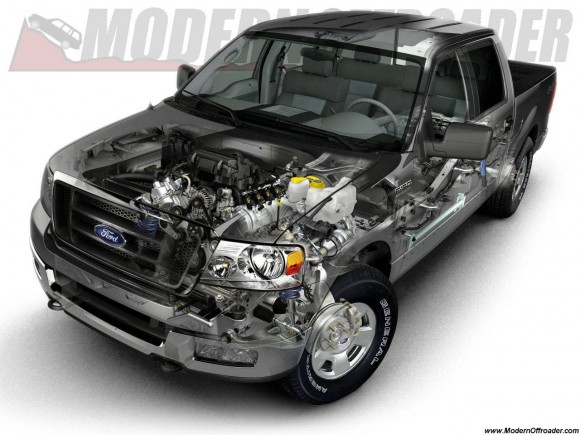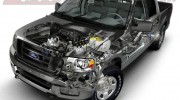
Ford F-Series, the best-selling full-size pickup for 30 years, is the culmination of 60 years of Built Ford Tough reliability, power and presence. Ford F-150 sets new standards in the industry for toughness, strength, safety, interior spaciousness, refinement, driving dynamics, stability, functionality, cargo capacity, comfort and style.
The Ford F-150 continues to offer the industry’s widest variety of body configurations, including three cab choices, three box lengths, two box styles and five unique series: the entry-level F-150 XL, fun and athletic F-150 STX, all-purpose F-150 XLT, powerful F-150 FX4, and the luxurious F-150 Lariat – to which the King Ranch version adds even more luxury. All cabs feature four doors for easy access.
With a maximum tow rating of 9,900 pounds when properly equipped and maximum payload capacity of 3,060 pounds, the F-150 is the most capable full-size pickup under 8,500 pounds.
The 300-horsepower Triton three-valve V8 engine powers the 2006 Ford Harley-Davidson F-150; a specially tuned exhaust system delivers a throaty rumble. Besides its 22-inch wheels, this truck includes a performance sport handling suspension that’s tuned to deliver a more precise driving feel. Customers now also have the choice between 4×2 and all-wheel drive, with the capability to handle more challenging driving conditions and road surfaces – ranging from dry pavement to winter weather. The new all-wheel-drive system continuously monitors the wheel speeds and throttle position to determine the appropriate amount of power to send to the front of the truck to help prevent slip.
The mainstream F-150 offers three engine choices for 2006: a 4.2L V6 engine, a 4.6L Triton V8 and the top-of-the-line 5.4L, three-valve Triton V8.
The 5.4L Triton V8 engine is designed with three valves per cylinder, variable cam timing and a host of other features that provide increased power along with a quieter operation and improved fuel efficiency. It delivers 300 horsepower at 5,000 rpm and 365 pound-feet of torque at 3,750 rpm. Later in the model year, a flex-fuel version that can use up to 85 percent ethanol will be available.
Segment-first torque-based electronic throttle control uses driver input from the accelerator pedal to actively modulate the torque at the drive wheels. The technology produces a seamless and consistent engine response, improved fuel economy and enhanced integration of vehicle systems, such as the transmission, variable camshaft timing, vehicle speed control and idle speed control.
Engineering advances in the F-150 lead to exceptional handling, ride and quietness. The fully boxed frame with hydroformed front rails is the strongest in its class and reduces shake and shudder on rough roads. The liquid-filled engine mounts or “hydromounts” on V-8 engine installations attenuate much of the engine’s noise and vibration before it can reach the passenger compartment.
A rack-and-pinion steering system – the largest and strongest ever used on a Ford vehicle – was engineered to provide improved steering response.
Both 4×2 and 4×4 models use coil-on-shock, long-spindle, double-wishbone front suspension with cast aluminum lower control arms – a first in the pickup truck segment. The suspension reduces unsprung weight to help provide better ride and stability on choppy, broken surfaces.
The Hotchkiss-design rear suspension has been optimized with rear shock absorbers placed outboard of the frame rails – a segment exclusive – for a smoother ride and improved control of body lean. The shock position also provides better control of axle “skipping” and “skating” that can happen on washboard-type surfaces.
The strong hydroformed front frame rails are built to help manage crash forces. In an impact, these areas of the frame are designed to collapse in an accordion fashion, dissipating energy before it reaches the passenger compartment.
As a result, F-150 is the only pickup in its class to earn NHTSA’s 5-star rating for driver and right-front-passenger frontal crash rating and receive a “Best Pick” in frontal offset crash testing performed by the Insurance Institute for Highway Safety.
The F-150’s portfolio of safety features includes the Ford Personal Safety System and occupant-sensing technology for the first-row passenger. Whether it’s a pair of work gloves, a child or an adult sitting there, the technology determines if the air bag should be on or off. The frontal air bags offer multiple deployment levels that tailor inflation force to the severity of the crash, the driver’s safety-belt use and the driver’s seat position as determined by a sensor mounted to the seat track.
Four-wheel vented-disc anti-lock brakes are standard. This year, 4×2 V8 models can be ordered with Traction Assist to improve acceleration and stability on slippery surfaces.
Selected options include mechanical or automatic shift-on-the-fly four-wheel-drive, skid plates, limited slip axle, 35.7-gallon fuel tank, heavy-duty payload package, trailer tow package and the snow-plow prep package.
Ford Motor Company































